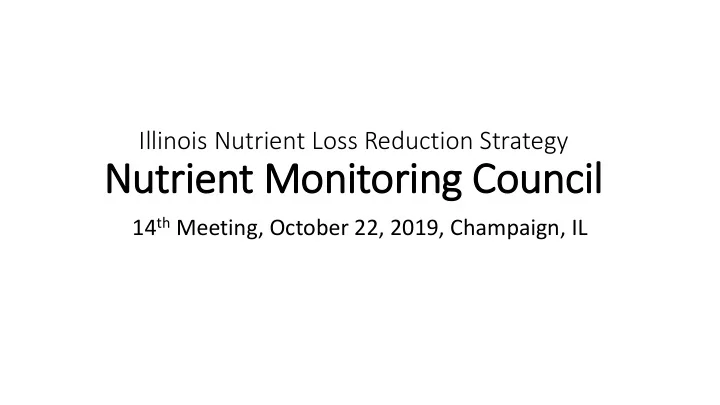

Illinois Nutrient Loss Reduction Strategy Nutri rient M Mon onitori ring Cou Counci cil 14 th Meeting, October 22, 2019, Champaign, IL
Welcome/Housekeeping Important Stuff – bathrooms, other Member and Guest Introductions Newsworthy Notes: Hold the Date – NLRS Partnership Conference 12/3-4/19
Discuss Method to Estimate Annual Statewide Nitrate and Total Phosphorus loads • USGS “Super Gages” capture approximately 75% of Illinois’ drainage area • Super Gages reports do not subtract loads contributed by other states
Science Assessment Update • Dr. McIsaac’s updated NLRS Science Assessment update • Calculated loads and yields on a HUC 8 basis using Illinois EPA Ambient Monitoring Network data • Nitrate-Linear Interpolation from 6 years of data • Total Phosphorus- WRTDS method from 6 years of data • Subtracted contributions from other states • Estimated loads where there are no monitoring stations • Statewide loads based on 8 major river systems
USGS Super Gage Stations
Green: Illinois EPA Ambient Drainage Area Blue Outline: NHD HUC 8 Watersheds Pink: HUC 8 Boundaries-IL only
Can we use annual data from “Green” areas to calculate load? Should we adopt a method to estimate annual loads from the “Pink” areas? How do we subtract loads from other states? Green: Illinois EPA Ambient Drainage Blue Outline: NHD HUC 8 Watersheds Pink: HUC 8 Boundaries-IL only Purple: USGS Super Gage Drainage
Questions to Consider • Can the Illinois EPA Ambient data provide a “good enough” estimate for nutrient loads on an annual basis (8-9 samples per year) • How to estimate for the remaining areas? • Science Assessment estimated loads based on nearby HUC 8s. • Calculated yield then applied yield to acres of unmonitored areas • Need to account for point sources • Adopt a watershed model to estimate nutrient loads from these HUCs? • Other? • What was the percentage of estimated loads contributed by these areas based on the updated Science Assessment? • How to subtract Wisconsin and Indiana nutrient load contributions? • Use data from select Illinois EPA Ambient stations? • OR……..
DO NOTHING….. • Will subtracting other states’ contributions and adding ungagged areas come close to canceling each other out? • Who will do the work? • Who will pay for it? • Maybe the USGS gages alone are good enough?
Recommend
More recommend